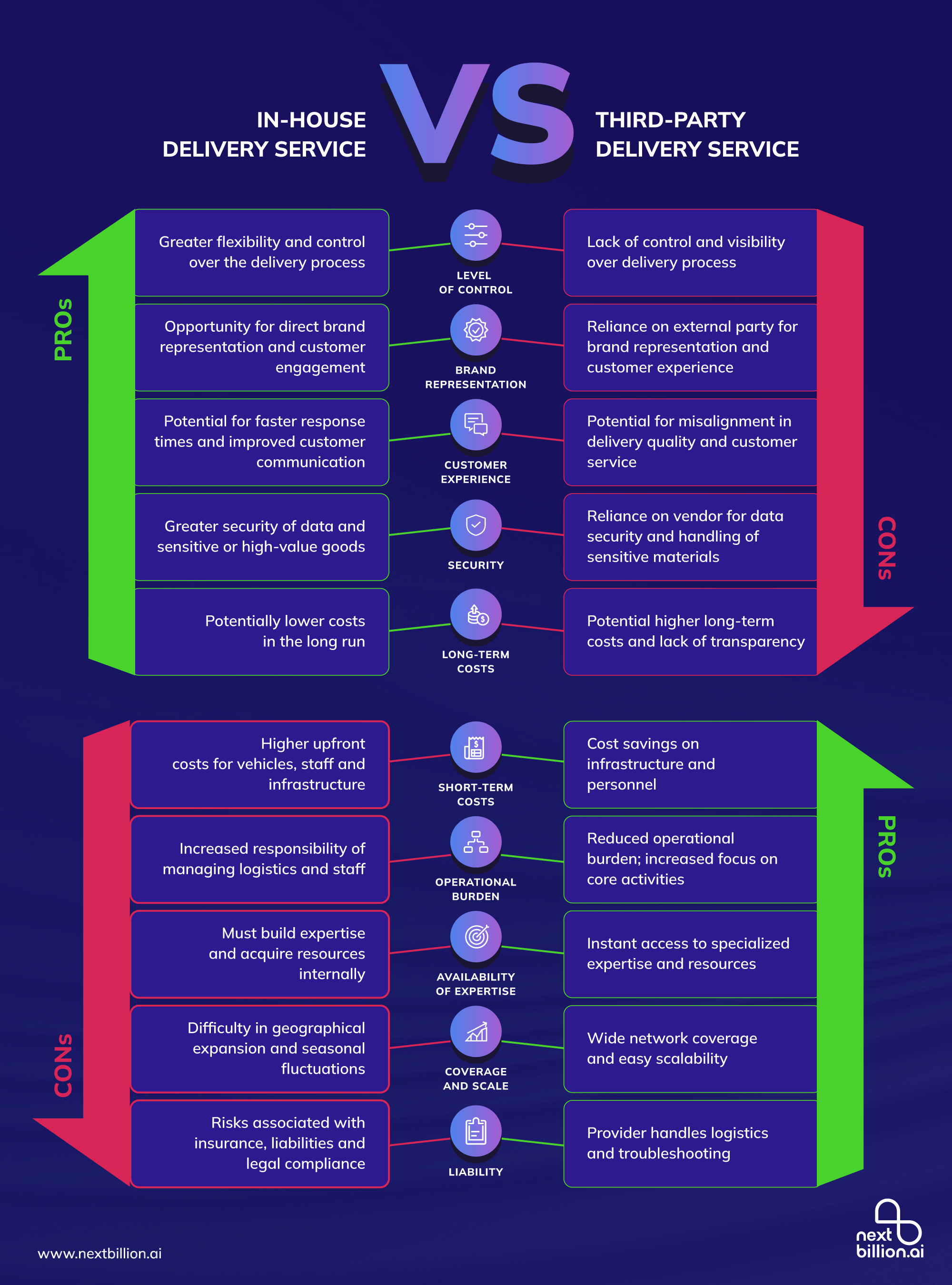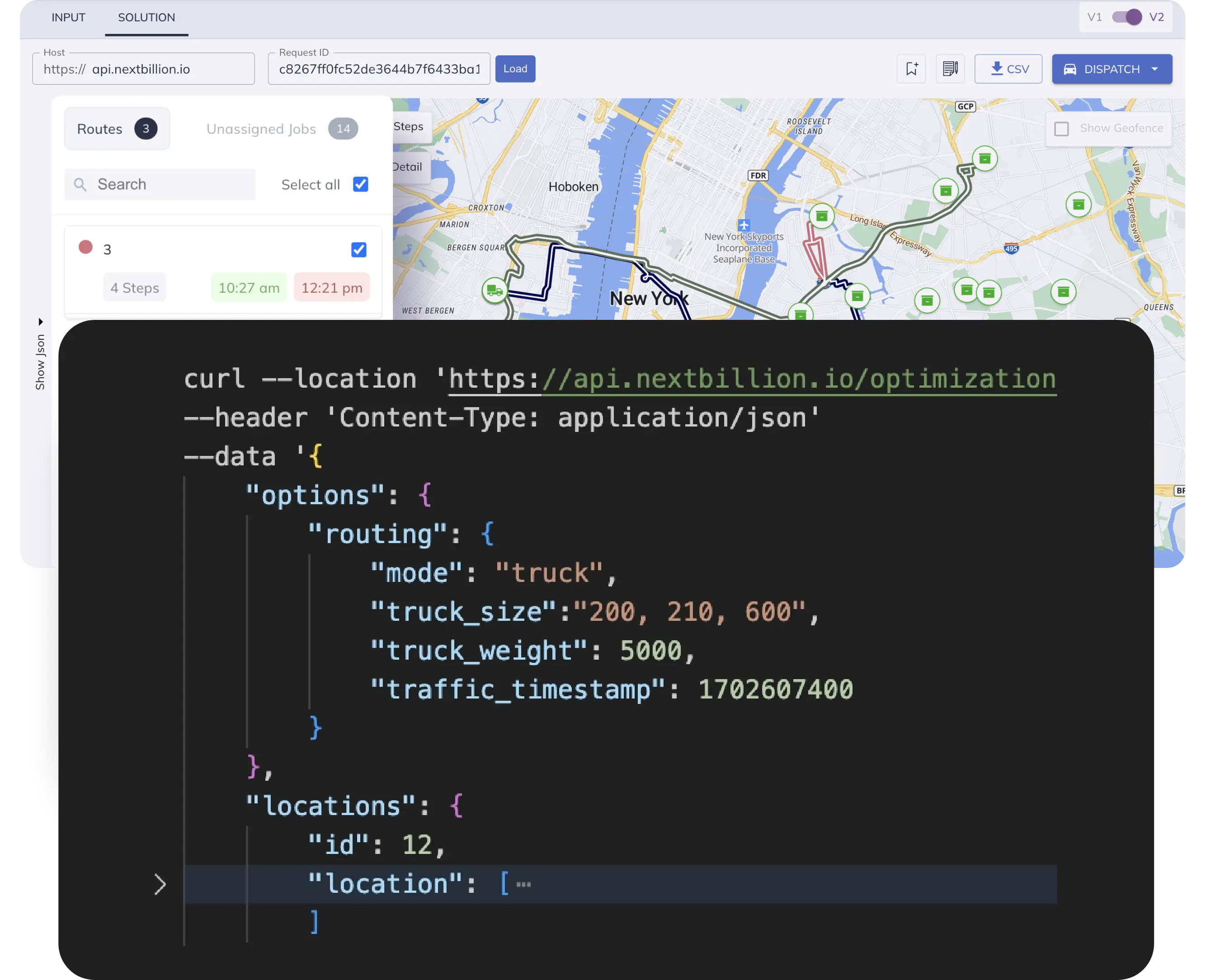Table of Contents
The quest for success in today’s business environment never ends — there’s always more to be had. This pushes organizations to constantly seek ways to improve operations and optimize resources. One key area that businesses must consider is their delivery model.
Should you handle delivery logistics internally or outsource it to a third-party delivery service provider? This decision can have a significant impact on your company’s bottom line, customer satisfaction and overall success.
Let’s explore the pros and cons of each model and key factors to consider when choosing your organization’s approach to delivery logistics.
THE BASICS OF THIRD-PARTY DELIVERY SERVICES
Outsourced delivery involves partnering with a third-party service provider who specializes in logistics and transportation to execute your deliveries.
Pros
Third-party delivery services offer a few advantages that make them an attractive option:
- Specialized providers have dedicated teams and resources that are solely focused on managing and optimizing delivery operations. They have extensive knowledge of logistics best practices, industry regulations and technological advancements. By harnessing their expertise, you can benefit from efficient and streamlined delivery processes without having to build your own infrastructure.
- Third-party delivery services have the resources and capacity to handle fluctuations in delivery volumes, ensuring that they can meet your customers’ demands during busy periods. They also offer greater geographical coverage, making it easier to expand your business into new markets without the need for significant infrastructure investments.
- Utilizing a third-party delivery service frees up the time and resources that your business would otherwise have to spend on managing logistics. This allows you to focus your organization’s energies on its core competencies and strategic initiatives.
Cons
Despite its advantages, outsourced delivery has its share of challenges, such as:
- Loss of control over the delivery process. Outsourcing leaves you at the mercy of third-party delivery service providers when it comes to meeting your organization’s service level agreements and imparting positive customer experiences. If the provider fails to meet expectations, your company may face reputational damage and lose customer trust.
- Outsourcing deliveries eliminates what might be one of just a few — or possibly even the only — direct physical interactions between your organization and its customers. which, again, could impact the customer experience and your ability to leave a lasting positive impression.
- Third-party delivery services typically operate within their own frameworks and may have limitations in terms of customization. If you have specific delivery requirements like specialized packaging, handling procedures or delivery time windows, outsourcing may not offer the level of flexibility you need.
THE BASICS OF IN-HOUSE DELIVERY LOGISTICS
In-house delivery is the process of managing and conducting deliveries within your organization’s own infrastructure. Your company employs its own drivers, owns its own vehicles and controls every aspect of the delivery process from start to finish.
Pros
Some of the biggest advantages of in-house delivery include:
- Handling your own delivery operations gives you complete control and visibility of the entire process. You can directly manage your drivers, vehicles and routes, ensuring that deliveries are executed as intended and customer requirements are met. This can be particularly important for businesses that handle sensitive or high-value goods.
- In-house delivery enables businesses to be more adaptable. Control over your delivery operations empowers you to make real-time adjustments to routes, schedules and other logistics factors, even mid-delivery, if needed. Such flexibility is especially beneficial in situations where unexpected changes or urgent deliveries arise.
- In-house delivery presents opportunities for direct interaction with customers, which can strengthen customer relationships and lead to repeat business.
Cons
Despite its advantages, in-house delivery also has its drawbacks:
- It requires significant investment for acquiring and maintaining a fleet of vehicles, hiring and training drivers, and establishing the necessary infrastructure and technology systems. This can be a substantial financial burden, especially for businesses with limited resources.
- Scaling in-house delivery can be complex and costly, as it involves expanding the fleet, hiring more drivers and potentially opening new distribution centers. Without proper planning and resources, companies may struggle to handle increased delivery volumes and risk compromising service quality.
- It takes time, effort and expertise to manage logistics operations. This can divert attention and resources away from your organization’s core competencies and strategic initiatives.
THE HIDDEN PITFALLS OF THIRD-PARTY DELIVERY SERVICES
There’s more to outsourcing logistics than meets the eye at first glance. Let’s take a look at a few pitfalls of third-party delivery services that may not be immediately apparent.
1. Misaligned Incentives
It’s worth noting that your priorities and those of third-party delivery service providers are unlikely to match perfectly. For instance, providers often prioritize speed of delivery over careful handling of packages. This can cause increased incidents of lost or damaged items, which leads not only to dissatisfied customers but also additional costs for your business. Replacing lost items, refunding customers and dealing with customer complaints can all take a toll on your company’s resources and reputation.
One way to address this issue is to establish clear performance metrics and incentives for the logistics provider. Utilize performance-based contracts to set specific goals such as minimizing the number of lost or damaged items, or tie the provider’s compensation to customer satisfaction metrics.
2. Data Security
Depending on how seriously your provider takes data protection, you may face challenges in maintaining control over customer data when outsourcing delivery logistics. In such cases, ensuring the proper protection of sensitive information becomes a critical concern.
It is essential to have protocols and agreements in place that guarantee the protection of customer data as required. This includes secure storage, transmission and disposal of sensitive information. You could also implement measures to monitor and audit the logistics provider’s data handling practices. Regular assessments and reviews can help identify any potential vulnerabilities or areas for improvement in data security.
3. Unpredictable Outcomes
Outsourcing to third-party delivery services can introduce unpredictability into your operations. External factors like weather conditions or strikes can disrupt deliveries and cause negative experiences.
One strategy is to establish strong relationships with multiple delivery service providers, mitigating the risks associated with relying on a single provider. This will give you the flexibility to switch to an alternative provider in case of unexpected disruptions.
Advanced tracking and monitoring systems can keep you informed about delivery statuses in real time. With this information, you can proactively communicate with your customers, manage their expectations and address any concerns they may have.
Another option is to work with your logistics provider to develop contingency plans. By anticipating potential challenges and identifying solutions in advance, you can ensure that you have a backup plan in place. This will enable you to quickly adapt to circumstances and minimize the impact on your customers.
4. Infrastructure Requirements
‘I thought one of the advantages of outsourcing was that I wouldn’t have to invest heavily in infrastructure,’ you’re probably thinking. While that is generally accepted as true, it’s not always necessarily the case.
For example, some third-party delivery services may require you to invest in new technology or software to integrate with their systems. This could incur significant upfront costs, as well as ongoing maintenance and updates to ensure continued smooth operations.
THE RECURRING COSTS OF IN-HOUSE DELIVERY
Initial investments aren’t the only thing you have to be wary of when it comes to in-house delivery logistics. There are a number of recurring costs you’ll need to keep in mind.
1. Labor
Labor costs can be a heavy financial burden, especially when managing large fleets or navigating complex delivery routes. Hiring and training personnel requires time and resources. Employee benefits, insurance and potential overtime costs all need to be accounted for. Challenges related to staffing issues, such as turnover or absenteeism, can also impact finances, service quality and customer satisfaction if not properly managed.
2. Fuel
Implement strategies to manage fuel costs effectively as oil prices fluctuate. This can include route optimization, monitoring fuel consumption and exploring alternative energy sources for delivery vehicles. Investing in fuel-efficient vehicles and regular maintenance can help mitigate the impact of fuel costs on overall delivery expenses.
3. Maintenance
Maintenance costs for vehicles, equipment and delivery software can impact the overall efficiency and cost-effectiveness of your in-house delivery operation.
4. Packaging Materials
You’ll need packaging materials — boxes, tape, labels, protective materials, etc. — to prepare goods for delivery. Choosing the right packaging material can help minimize the risk of damage during transit, reducing costs associated with returns or replacements.
5. Warehouse or Storage Space
If you make use of inventory or storage facilities for your products, you’ll incur recurring costs for renting or maintaining warehouse space. These costs could include rent, utilities, security systems, shelving and equipment necessary to handle and store products.
6. Insurance
It is crucial to have insurance coverage to protect your operation against liabilities like accidents, property damage, theft or loss of goods during transit. Insurance premiums are recurring expenses that need to be factored into your budget.
KEY CONSIDERATIONS WHEN CHOOSING A DELIVERY MODEL
Condensing all of what we’ve covered above into just a few headings, the following are some of the key points you’ll need to consider when deciding upon a delivery model for your organization.
1. Cost Implications
Assess the upfront costs of building an in-house infrastructure versus the ongoing fees of outsourcing. It’s important to consider not only the immediate financial impact but also the long-term cost implications, including potential savings and scalability benefits.
2. Control Over Operations
In-house delivery offers complete control and visibility, enabling custom processes and consistent service quality and security. Outsourced delivery, on the other hand, gives you access to specialized expertise and resources but limits your direct control over deliveries. Weigh your priorities and determine which trade-offs you’re comfortable with.
3. Scalability and Flexibility
In-house delivery can be more challenging to scale, as it requires more investments and resources. Third-party delivery services offer greater flexibility and operational agility. Evaluate your business growth plans and decide which delivery model can best support your future needs.
4. Quality of Service
This one is all about the customer experience. In-house delivery allows for greater control over service levels, as you can train and manage your drivers as you see fit. Outsourcing relies on the expertise and performance of third-party delivery service providers. If you’re going with outsourcing, check the reputation and track record of potential providers to ensure they can consistently meet your service standards.
Different companies can make successful choices based on their unique circumstances and priorities. Ultimately, the right delivery model depends on factors such as your organization’s size, budget, growth plans and desired level of control. Carefully evaluate your priorities and make an informed decision on the delivery model that most closely aligns with your goals and circumstances.
Schedule a call with our team to see how NextBillion.ai can help you build an in-house delivery system.
Ready to get started?
Request a DemoTable of Contents







